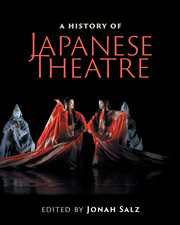Book contents
- Frontmatter
- Contents
- List of figures
- List of tables
- Contributors
- Contributors’ biographies
- Foreword
- Acknowledgments
- Note on Japanese terms
- List of abbreviations
- Timeline
- Editor's introduction
- I Traditional theatres
- Preface to Part I Japanese civilization arises
- II Modern theatres
- Preface to Part II
- III Arcs and patterns
- 12 Premodern playwriting practices
- 13 Traditional meta-patterns
- 14 Modern plays as literature
- 15 Modern meta-patterns
- Interlude Dōjōji: The lady and the bell
- IV Theatre architecture
- Preface to Part IV Evolution of Japanese theatre architecture
- V Theatre criticism
- VI Intercultural influences
- Epilogue: Frozen words and mythology
- Further reading
- Index
13 - Traditional meta-patterns
from III - Arcs and patterns
Published online by Cambridge University Press: 05 July 2016
- Frontmatter
- Contents
- List of figures
- List of tables
- Contributors
- Contributors’ biographies
- Foreword
- Acknowledgments
- Note on Japanese terms
- List of abbreviations
- Timeline
- Editor's introduction
- I Traditional theatres
- Preface to Part I Japanese civilization arises
- II Modern theatres
- Preface to Part II
- III Arcs and patterns
- 12 Premodern playwriting practices
- 13 Traditional meta-patterns
- 14 Modern plays as literature
- 15 Modern meta-patterns
- Interlude Dōjōji: The lady and the bell
- IV Theatre architecture
- Preface to Part IV Evolution of Japanese theatre architecture
- V Theatre criticism
- VI Intercultural influences
- Epilogue: Frozen words and mythology
- Further reading
- Index
Summary
Creative constraints on Japanese traditional genres have produced performances of tremendous theatrical potency. Troupes have adroitly exploited their strengths, negotiating the desires and demands of spectators and patrons, and evolving conventions and customs. Genres are classified according to a great specificity of repertoire, styles, and physical stages. These developed as a result of a proclivity of performance venues throughout the medieval era, then strict enforcement of building and sumptuary regulations by the Tokugawa shogunate (1603–1868), followed by standardization through teaching under the iemoto (headmaster) system. While differing greatly in content, acting style, mise-en-scène, and spectatorship, the traditional dramatic and dance forms share a remarkable number of meta-patterns – enduring expressions of this isolated island nation's character, common historical circumstances, and artistic tendencies. This chapter explores meta-patterns of staging (role and space specialization; distinction of visual/aural channels; transformations) and spectatorship (actors’ theatre; connoisseurship; local and seasonal accommodations), and their synthesis in iconic poses and imagery.
Role specialization and spatial framing
Specialization is key to the organization and aesthetics of Japanese super-elaborate performance genres. Once this was founded as a professional genre, troupe members quickly created systems of specialized roles. This occurred in noh (shite lead, waki side man, shoulder, hip, or stick drum and flute musicians, or kyogen comedian), in bunraku (chanter or puppeteer [body, left arm, leg]), and in kabuki (swashbuckling aragoto hero, onnagata femme fatale and so on). Moreover, among all traditional arts, only katari traditions such as bunraku and rakugo have required their respective chanters and raconteurs to possess broad vocal artistry, narrating in addition to portraying all characters in any play. While in some genres, such as kabuki, performers can advance to progressively more complex roles, in others an actor spends decades or even a lifetime confined to specific roles. A Shakespearian spear-carrier might later play Laertes and succeed to Hamlet, but the career trajectory of a noh accompanying waki player will never raise him to stardom. Instead he learns waki roles for each of the 200 or so plays in the repertoire, including diverse stylistic school versions and kogaki variants, playing this supporting role throughout his life.
As each genre developed increasingly specialist roles, playwrights were better able to utilize role types for more complex plots, which in turn created greater specificity of role type articulation and sophistication.
- Type
- Chapter
- Information
- A History of Japanese Theatre , pp. 376 - 385Publisher: Cambridge University PressPrint publication year: 2016



